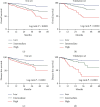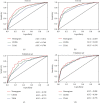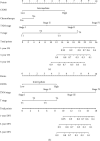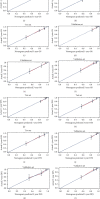An Oxidative Stress Index-Based Score for Prognostic Prediction in Colorectal Cancer Patients Undergoing Surgery
- PMID: 33505587
- PMCID: PMC7811428
- DOI: 10.1155/2021/6693707
An Oxidative Stress Index-Based Score for Prognostic Prediction in Colorectal Cancer Patients Undergoing Surgery
Abstract
Oxidative stress plays an important role in the development of colorectal cancer (CRC). This study is aimed at developing and validating a novel scoring system, based on oxidative stress indexes, for prognostic prediction in CRC patients. A retrospective analysis of 1422 CRC patients who underwent surgical resection between January 2013 and December 2017 was performed. These patients were randomly assigned to the training set (n = 1022) or the validation set (n = 400). Cox regression model was used to analyze the laboratory parameters. The CRC-Integrated Oxidative Stress Score (CIOSS) was developed from albumin (ALB), direct bilirubin (DBIL), and blood urea nitrogen (BUN), which were significantly associated with survival in CRC patients. Furthermore, a survival nomogram was generated by combining the CIOSS with other beneficial clinical characteristics. The CIOSS generated was as follows: 0.074 × albumin (g/L), -0.094 × bilirubin (μmol/L), and -0.099 × blood urea nitrogen (mmol/L), based on the multivariable Cox regression analysis. Using 50% (0.1025) and 85% (0.481) of CIOSS as cutoff values, three prognostically distinct groups were formed. Patients with high CIOSS experienced worse overall survival (OS) (hazard ratio [HR] = 4.33; 95% confidence interval [CI], 2.80-6.68; P < 0.001) and worse disease-free survival (DFS) (HR = 3.02; 95% CI, 1.96-4.64; P < 0.001) compared to those with low CIOSS. This predictive nomogram had good calibration and discrimination. ROC analyses showed that the CIOSS possessed excellent performance (AUC = 0.818) in predicting DFS. The AUC of the OS nomogram based on CIOSS, TNM stage, T stage, and chemotherapy was 0.812, while that of the DFS nomogram based on CIOSS, T stage, and TNM stage was 0.855. Decision curve analysis showed that these two prediction models were clinically useful. CIOSS is a CRC-specific prognostic index based on the combination of available oxidative stress indexes. High CIOSS is a powerful indicator of poor prognosis. The CIOSS also showed better predictive performance compared to TNM stage in CRC patients.
Copyright © 2021 Yinghao Cao et al.
Conflict of interest statement
The authors declare that there is no conflict of interest regarding the publication of this paper.
Figures






Similar articles
-
A nomogram based on pretreatment levels of serum bilirubin and total bile acid levels predicts survival in colorectal cancer patients.BMC Cancer. 2021 Jan 21;21(1):85. doi: 10.1186/s12885-021-07805-9. BMC Cancer. 2021. PMID: 33478423 Free PMC article.
-
Development and validation of a nomogram to predict survival after curative resection of nonmetastatic colorectal cancer.Cancer Med. 2020 Jun;9(12):4126-4136. doi: 10.1002/cam4.3010. Epub 2020 Apr 21. Cancer Med. 2020. PMID: 32314876 Free PMC article.
-
Creation of a Novel Inflammation-Based Score for Operable Colorectal Cancer Patients.J Inflamm Res. 2020 Oct 6;13:659-671. doi: 10.2147/JIR.S271541. eCollection 2020. J Inflamm Res. 2020. PMID: 33116746 Free PMC article.
-
Performance of prediction models on survival outcomes of colorectal cancer with surgical resection: A systematic review and meta-analysis.Surg Oncol. 2019 Jun;29:196-202. doi: 10.1016/j.suronc.2019.05.014. Epub 2019 May 20. Surg Oncol. 2019. PMID: 31196488
-
Development and validation of a preoperative systemic inflammation-based nomogram for predicting surgical site infection in patients with colorectal cancer.Int J Colorectal Dis. 2024 Dec 21;39(1):208. doi: 10.1007/s00384-024-04772-y. Int J Colorectal Dis. 2024. PMID: 39707016 Free PMC article. Review.
Cited by
-
Identification of Novel Core Genes Involved in Malignant Transformation of Inflamed Colon Tissue Using a Computational Biology Approach and Verification in Murine Models.Int J Mol Sci. 2023 Feb 21;24(5):4311. doi: 10.3390/ijms24054311. Int J Mol Sci. 2023. PMID: 36901742 Free PMC article.
-
Systematic oxidative stress indices predicts prognosis in patients with urothelial carcinoma of the upper urinary tract after radical nephroureterectomy.Eur J Med Res. 2023 Oct 28;28(1):469. doi: 10.1186/s40001-023-01295-0. Eur J Med Res. 2023. PMID: 37898799 Free PMC article.
-
Development and validation of a competitive risk model in patients with rectal cancer: based on SEER database.Eur J Med Res. 2023 Sep 21;28(1):362. doi: 10.1186/s40001-023-01357-3. Eur J Med Res. 2023. PMID: 37735712 Free PMC article.
-
Preoperative integrated oxidative stress score as a prognostic factor for predicting clinical outcomes in breast cancer patients received neoadjuvant chemotherapy: a real-world retrospective study.Int J Med Sci. 2025 Feb 26;22(6):1437-1449. doi: 10.7150/ijms.109915. eCollection 2025. Int J Med Sci. 2025. PMID: 40084249 Free PMC article.
-
An oxidative stress biomarkers predict prognosis in gastric cancer patients receiving immune checkpoint inhibitor.Front Oncol. 2023 Jul 20;13:1173266. doi: 10.3389/fonc.2023.1173266. eCollection 2023. Front Oncol. 2023. PMID: 37546387 Free PMC article.
References
-
- Mahar A. L., Compton C., Halabi S., Hess K. R., Weiser M. R., Groome P. A. Personalizing prognosis in colorectal cancer: a systematic review of the quality and nature of clinical prognostic tools for survival outcomes. Journal of Surgical Oncology. 2017;116(8):969–982. doi: 10.1002/jso.24774. - DOI - PMC - PubMed
MeSH terms
LinkOut - more resources
Full Text Sources
Other Literature Sources
Medical
Miscellaneous

